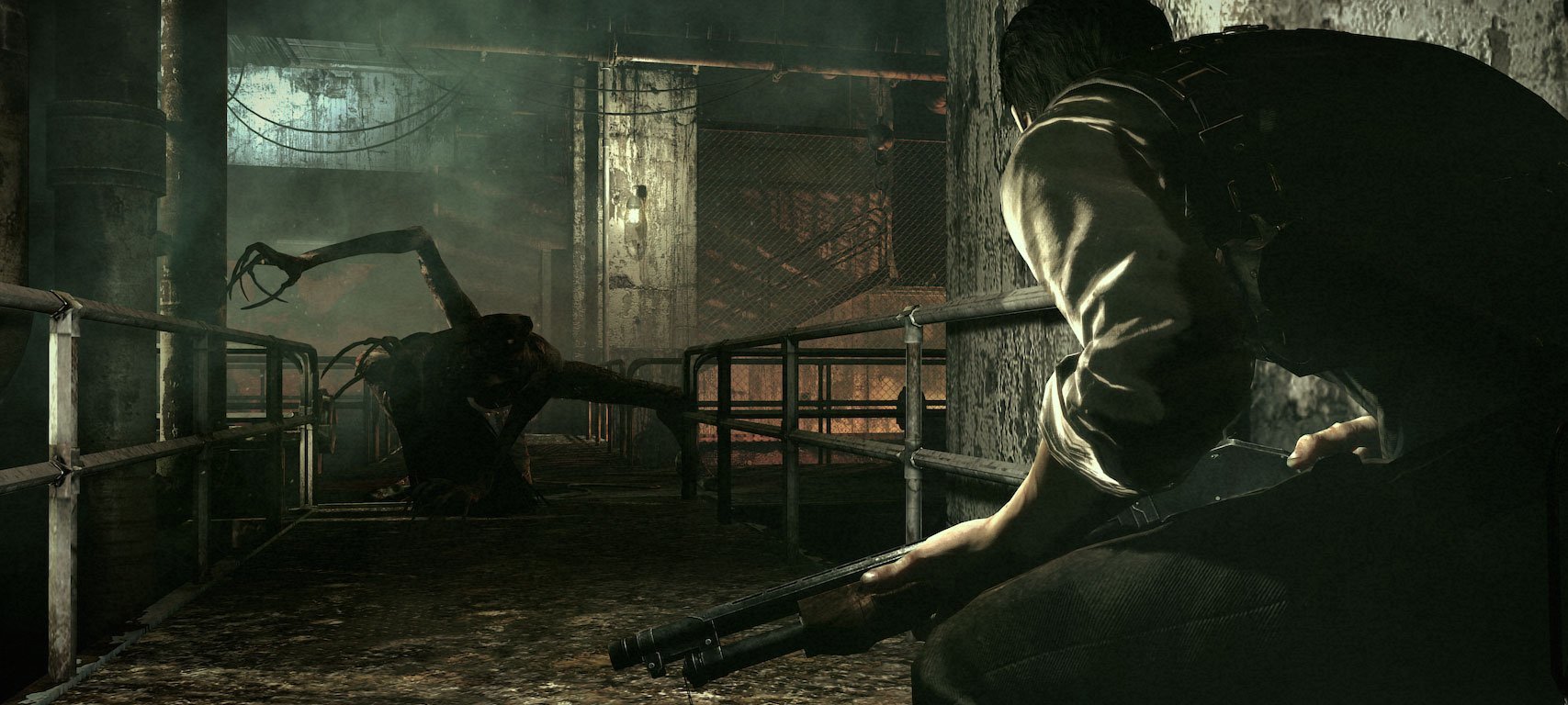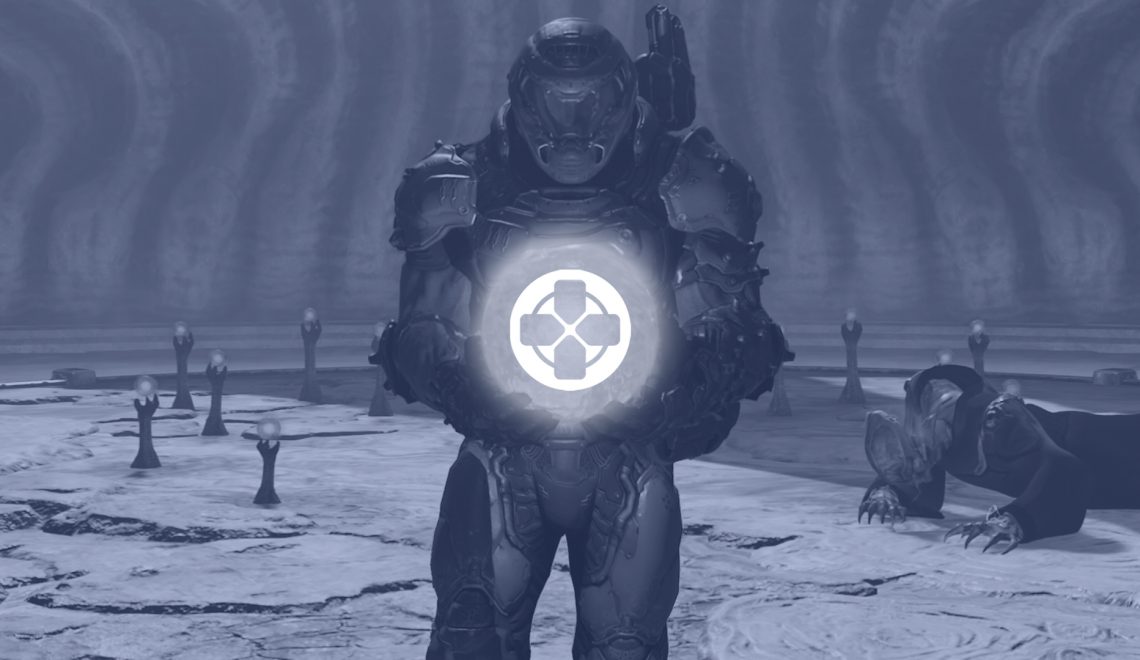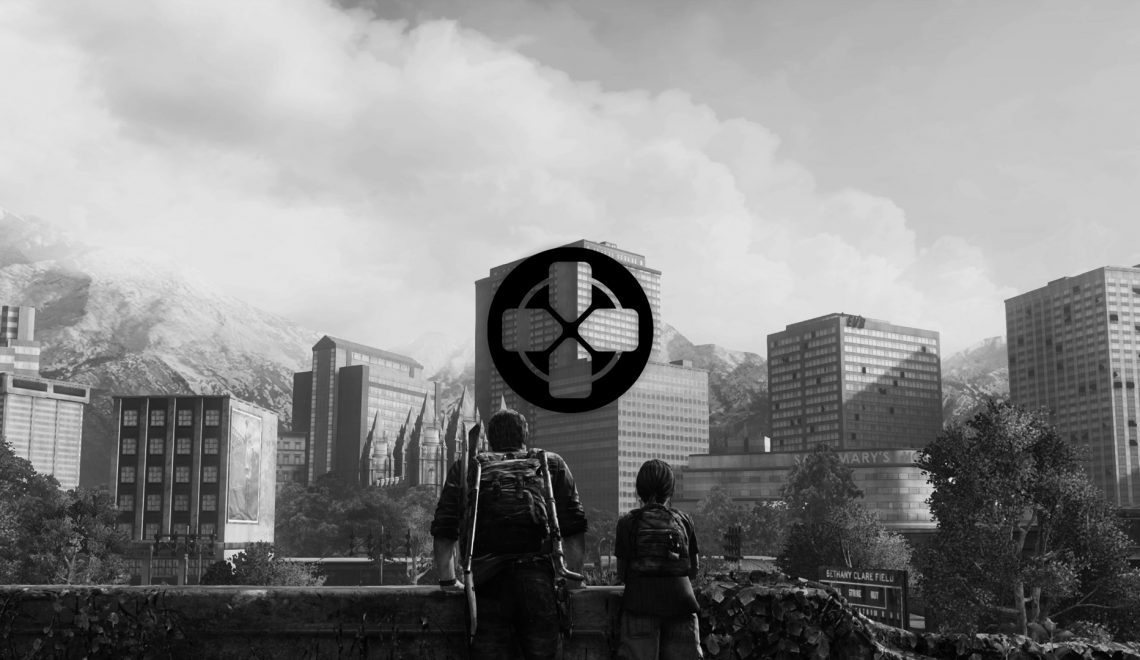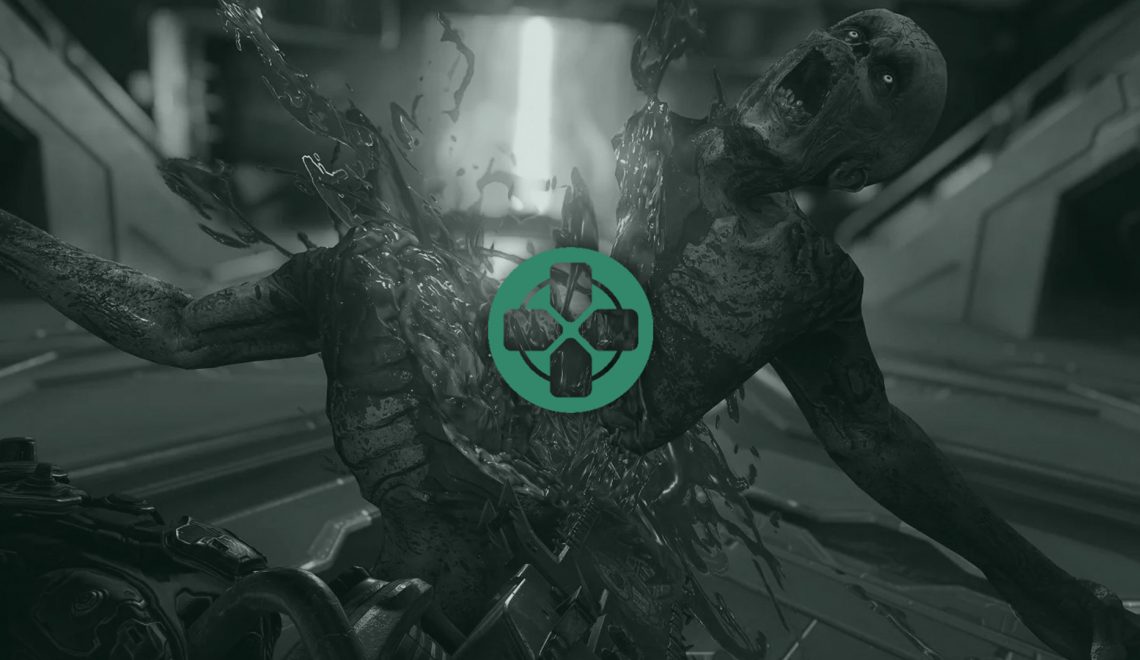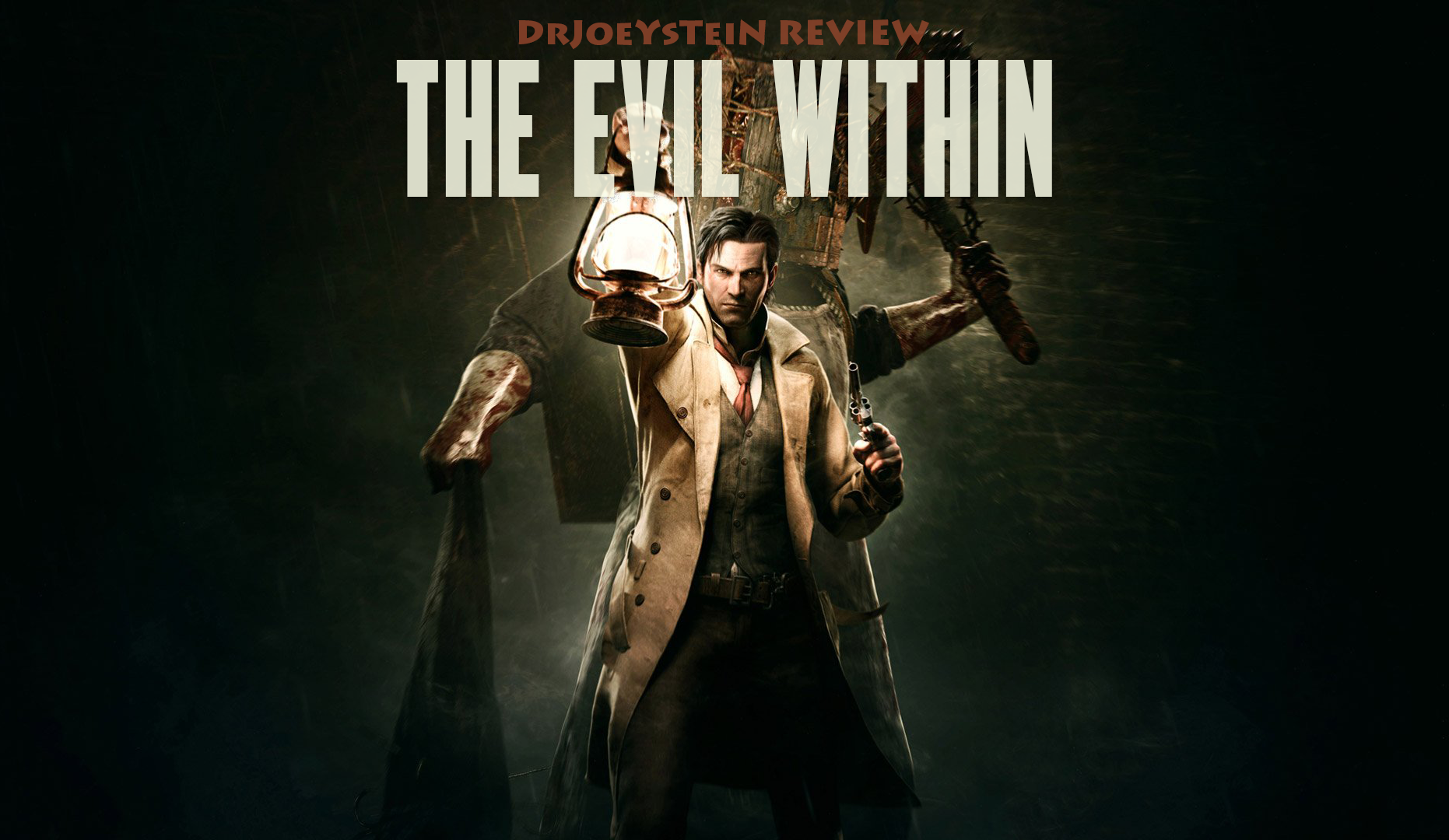
2014 was an interesting year for horror games. Dying Light, Five Nights at Freddy’s, and several indie titles were pretty big highlights, but surprises like Alien: Isolation and P.T. were unexpected in how they seemed to buck the recent trend of “actionizing” this genre by reintroducing old school mechanics and/or toning down gameplay to make foes scarier, have players be more methodical in gathering supplies and navigating levels, and whatnot, which fairly recent poster boys for the genre like Dead Space 3 (still a good game though) and Resident Evil 6 neglected in favor of Hollywood-style spectacle, more power to the protagonist, a decreased sense of vulnerability and helplessness, and so on. It’s not that games like these are bad on that basis alone, but it’s still disappointing to see them shake off aspects of survival and horror that cemented their predecessors as…well, defining survival-horror.
Ah, and then there’s The Evil Within! I can’t talk about last year and this genre without mentioning it. Shinji Mikami directed it, who’s practically the father of survival-horror since he was also the director of a little PlayStation game in 1996 called Resident Evil. He worked on all of the subsequent titles up until the masterpiece known as Resident Evil 4 (where he resumed being director after the other two main games), so it’s no question that The Evil Within is just as legendary…right?
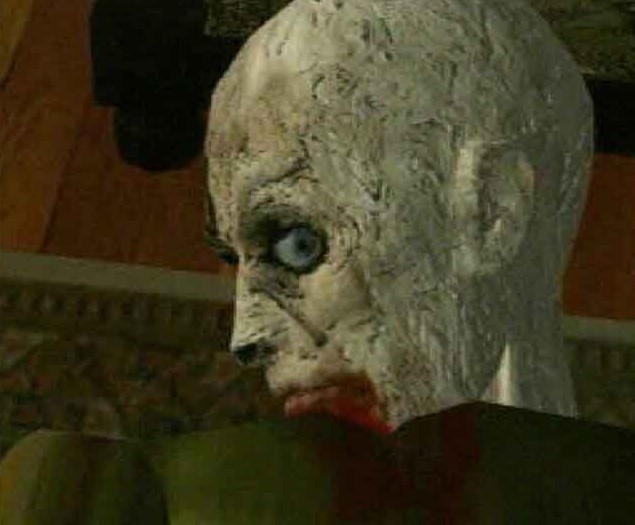
A moment that chilled all to the bone. The blank stare, bloodstained lips, and cracked, pasty white skin. Mikami-san is a master of horror.
Video game journalists and gamers alike were surprisingly divided on its merit with critiques ranging from labeling the game below average to excellent. I’ll admit that as a survival-horror fanatic, I heavily looked forward to the game, but upon playing it for the first time, I was worried that I wouldn’t enjoy it as much as I originally anticipated due to the letterbox screen, clunky controls, an insanely confusing story, and other negative factors I experienced for the first three hours. Now, the question is if my tour through this madhouse of a game morphed into an even worse nightmare as I trudged along to the end. Or perhaps more time with it altered some of my negative points of view and allowed me to appreciate aspects of The Evil Within others didn’t care for or see?
I guess I might be going mad, but I really like it despite its flaws. The main reason for my positive feelings goes back to what I was alluding to earlier about the current, unsure evolution of survival-horror. In playing The Evil Within, I was surprised that it poses questions in its design pointed to this issue. What if an unabashedly old school survival-horror game were made – to the point of being arguably archaic – with modern technological conventions and an AAA budget? Would it simply be out of time and place, a mess of a project with conflicting design and mechanics, or exactly what we need in a genre struggling to root itself in this era of gaming? The answers are brought to the table by Mikami-san in simply bringing this game into existence, and boy, has it been an interesting one to play and ponder over.
There’s a Certain Genius to Madness
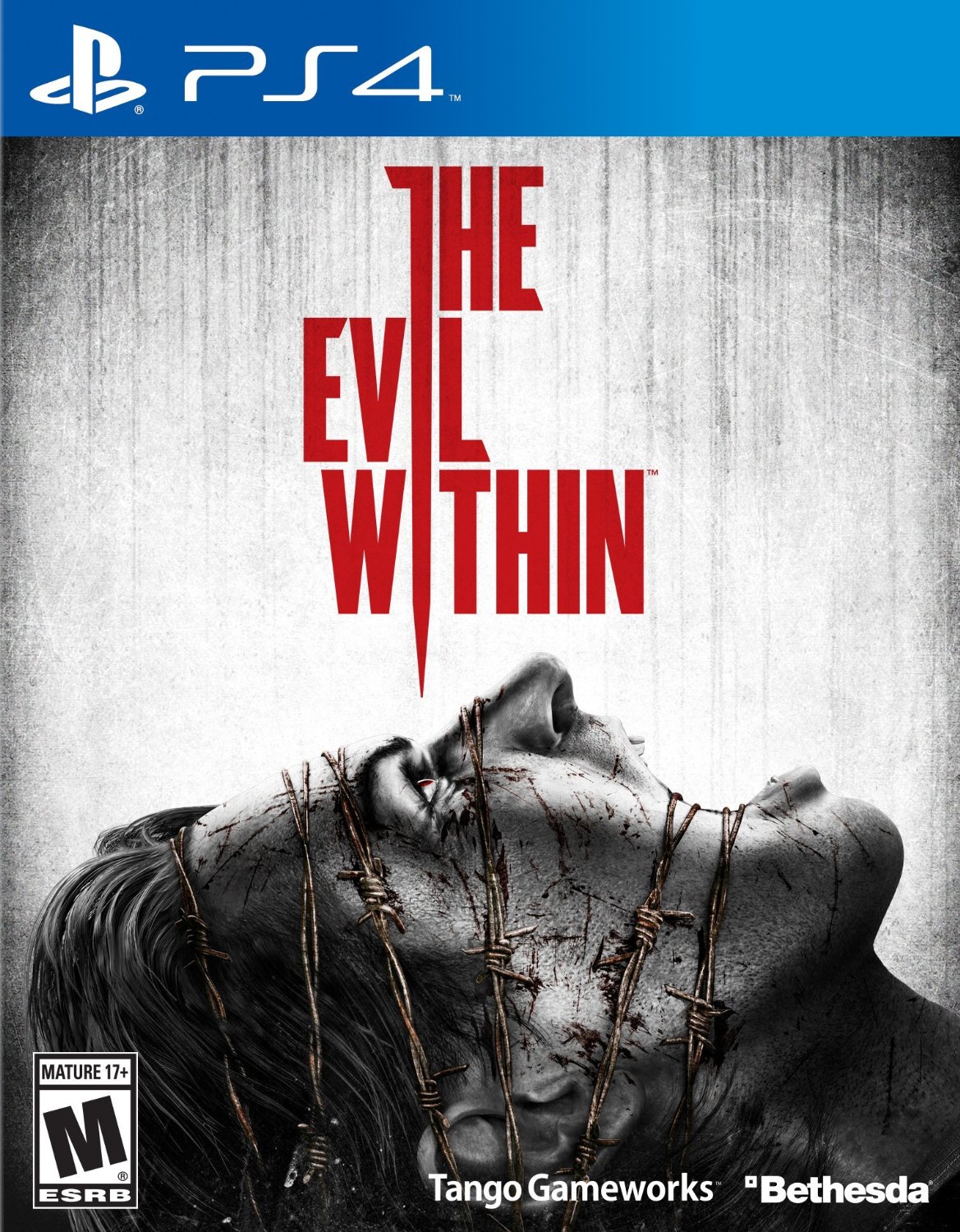
Title: The Evil Within
Developer: Tango Gameworks
Publisher: Bethesda
Release Date: 10/14/2014
Platforms: PC, PS4, Xbox One, PS3, & Xbox 360
Genre: Survival-Horror / Third-Person Shooter
Reception (Metacritic): 70%
Gameplay
You can think of The Evil Within as a spiritual successor to Resident Evil 4. It’s an accurate comparison, and not a negative one in the slightest. While the movement isn’t quite like tank controls, it’s in the same vein since movement is deliberate. You have a stamina bar to run for brief (and I mean brief) periods of time, a crouch button to sneak by or hide from enemies, and a swaying aim reticle that make the handling of firearms an exercise in patient execution. Lapses in judgment or hasty grabs at eliminating foes will take blows at your accuracy, stealth, and/or strategic positioning in how you conquer scenarios. Sometimes though these limitations will feel cheap. Shots will somehow miss at times despite seemingly pinpoint accuracy, general movement feels kind of clunky and rigid when you want to make small, precise motions, and you can only sprint without stopping for a few seconds before the character must literally stop and catch his breath. However, these design choices add to the challenge of playing The Evil Within rather than feeling more like annoyances.
Let’s expand on that. Sparse ammo, a health meter that can take big hits, nearly useless melee attacks, infrequent health vials and packs, weapons that aren’t overpowered…these are the limitations and challenges you face that put you in a position from the start where everything at your disposal is and should be enough to take down any opposition, but one slipup or lapse in judgment could spell your downfall or make matters worse in an instant. The awesome tension this creates is dampened since I found save locations and checkpoints too frequent for the most part (some spots had some pretty nerve-wracking separation between places of refuge though!), but still, everything from all-out action to taking out a single enemy that comes out of nowhere will keep you alert at all times.

“Bro, you’re a bit slack-jawed there. Don’t come over here asking for kisses until you fix that!”
The satisfying collection of foes and bosses you’ll encounter throughout The Evil Within ensures you’ll come across a mix of fresh and familiar threats at a wonderful pace. The average bad guys called “Haunted” are essentially zombies with intelligence, which can dodge your weapon’s line of sight at times, sprint at unexpected moments toward you, or even wield melee weapons or guns. A few will be invisible or morph into a faster, even more dangerous form that can instakill you, and others may have protective masks and/or body armor that prevent you from landing headshots or taking them out from any angle. Some bosses are impossible to beat with weaponry at times and can only be eliminated with specific methods by using the environment around you, while another is a hulking bullet sponge that will have you shooting and running all over the place like a madman. While I was extremely careful to preserve supplies and usually felt ready for any situation, this fantastic lineup of crazies (with the exception of 1-2 boring bosses) pressed me at times no matter what I did. While some of the usual enemies got stuck in the environment or did something silly on rare occasions, the overall AI is superb on harder difficulties.
There are puzzle-solving elements with visual riddles, key items used to progress to new sections of a level, and more that usually involve backtracking in small areas for a short time, much like the puzzles in the first Resident Evil. While some of them were lost on me due to being unnecessarily vague, nearly all of them were welcome in breaking up the action. When it comes to the level design, it’s linear and bland in some places, but the majority of it consists of memorable, fairly open locations where your stealth and/or skill in combat will be tested alongside your ability to use the objects around you and environment to your advantage. You’ll have multiple avenues in tackling some big scenarios, such as by using instant stealth takedowns from behind until you need to go in guns blazing, or perhaps strategically exploiting high ground that’s beneficial in picking off enemies in a certain order with certain weapons. The possibilities are there and offer some surprising freedom by allowing players to figure out how to best approach some areas in between fairly straightforward segments.
Now, it’s not only enemies that will pose trouble, but also the environment. Snags like motion-sensor bombs and trip wires can spell your doom by halting an escape or depleting the last of your health if you’re not cautious. I shook my head at my carelessness sometimes, but appreciated these cleverly laid out tricks by Tango Gameworks, especially since if you spot them, you can be rewarded if you’re quick or clever enough. What I mean is that they can be disabled – sometimes with great risk demanding fast reflexes – to acquire gears (which I’ll talk about soon) or used against your adversaries, which can add spontaneous layers of depth to some of the plans you’ll be laying out in eliminating targets. You’ve got other reasons to look around, too, since you can find keys that unlock vaults with randomized supplies in the save room (it’s a hub area of sorts) you’ll visit countless times. These keys are genuinely hard to find since they’re deviously hidden away in secret rooms, inside objects you wouldn’t usually look at twice, etc. Most importantly though, besides breaking boxes and vases for standard supplies (sound familiar?), is this green gel or, as I like to call it, “brain juice.” It’s found in varying quantities throughout every level in nooks and crannies and acts as a currency to enhance your character’s attributes. It’s a neat, unexpected RPG system that gives you the option to upgrade the accuracy or ammo capacity of your shotgun, increase your amount of sprint time or health, and much more.
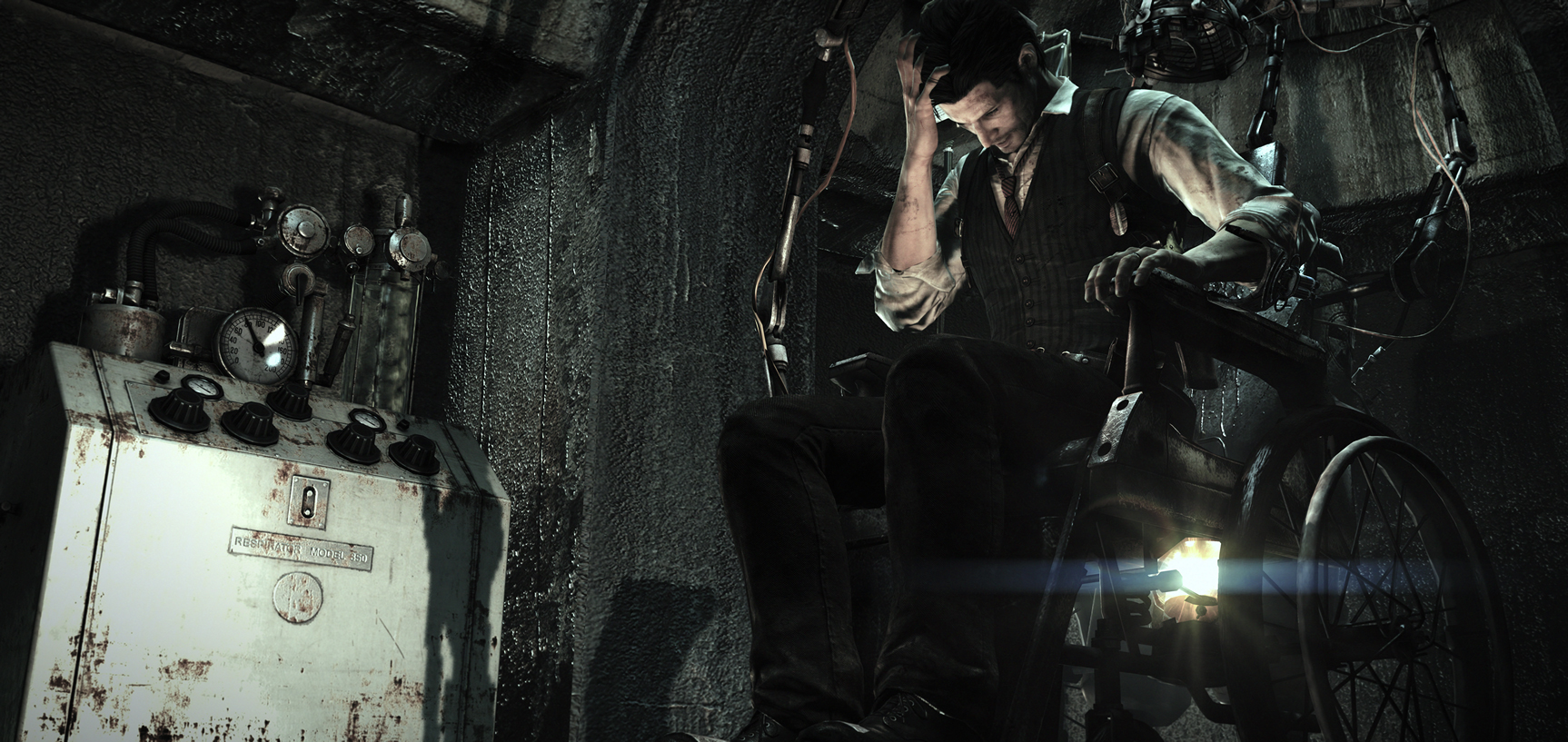
This chair may look like a death trap, but trust me, it’s only where you electrify your brain to learn new skills with your green brain juice. What? Oh, yeah, it’s safe.
While I looked forward to doing this every chance I got, I didn’t like how a fair portion of the upgrades seemed pointless in how little they did despite being labeled with steep prices. This forced me to gravitate to objectively more useful upgrades, and thankfully they’re worth the time and effort to invest brain juice in (that’s something you don’t hear every day :P). Even the weapons are similar in this respect: they’re worth upgrading considering the pistol, shotgun, sniper rifle, and crossbow contrast each other in a nice balance. The crossbow in particular is a strange one though, which uses up to four arrow types that impale, freeze, explode, or electrify foes. It’s a crazy element in your arsenal useful for crowd control or halting enemies dead in their tracks, only adding more to the diversity of approaches you can take. Also, what’s especially a telltale, old school design choice is that you receive most of these weapons and more powerful versions in silver cases you’ll find directly on or off the beaten path. So keep an eye out, because you may be missing something very helpful (like I did with a couple weapons) if you’re not observant enough!
Gosh, that was a mouthful, wasn’t it? The Evil Within may be a hit-and-miss in some areas with the game design, but overall, the limitations and fun weapons of the protagonist, relentless enemies and level design, solid upgrade system, enjoyable puzzles, and nice incentives for being exploratory make it a throwback to traits Resident Evil, Silent Hill, and the like had that contributed to the survival-horror genre back in the day. It perhaps relies too much on old principles than making innovative changes to this genre, but the game proves in doing this that old school survival-horror can find a home in this generation since it envelops the player not necessarily in fear while playing it, but in a constant state of fun yet nervous anticipation and alertness since they can only do so much with what they’ve been given in a cruel game world. That’s a huge part of what survival-horror is all about.
Story
Sebastian Castellanos, Juli Kidman, and Joseph Oda are officers of the Krimson City Police Department, and they’re on their way to investigate multiple homicides at the Beacon Memorial Hospital. They pull up to the entrance to discover multiple police cars unoccupied and an eerie quiet over the vicinity. Sebastian and Joseph go inside while Juli is left to watch guard, and what the first two see is a scene they won’t forget. Gashed corpses and pools of fresh blood litter the reception room floor, but both of them find a doctor who’s conscious in the nearby security room. Sebastian goes to check the footage on the video feeds in there to see where all his fellow officers are, but discovers something horrible in the process. He witnesses a hooded man with a white robe cut down several of them in a hallway at preternatural speed, who then vanishes and appears behind Sebastian while striking him in the head! He awakens later tied and hanging upside down in a hellish butchery filled not with animal bodies, but chopped human remains, managing to escape by the skin of his teeth after being injured and chased by the butcher himself. Sebastian comes to the conclusion something is wrong with this place. Deformed humans, torture devices, and gore define the out-of-place environments he finds himself in at every turn, which even morph and change in front of his very eyes. It’s his job to find that doctor, Joseph, Juli, and anyone sane in this nonsensical nightmare, and perhaps find out what in the world is going on!
Sebastian is a hard-boiled detective with a record of accomplishments marred with a life-shattering tragedy. If there’s one thing he can do, it’s to survive.
One thing that disappointed me from reading reviews is that the story is uninspired, has little sense of direction, contains unmemorable characters, and the like. The thing with most survival-horror games is that I’m not primarily looking for an emotionally thick story with intricate themes, but a simple one that builds on an interesting world with memorable (not necessarily deep) characters, if that makes sense. And that’s what The Evil Within accomplishes better in some areas than most survival-horror games. Firstly, I don’t understand why some don’t like the way in which the plot is conveyed. You have to consider the context of how we’re experiencing it through the protagonist before you can say it’s “confusing” or “without direction,” because that’s exactly how it’s supposed to feel to the player for the first half of the game! As Sebastian, the player has no clue what’s supposed to be happening. One second you’re going to a crime scene, and 20 minutes later you’re watching the city collapse around you, later waking up in a forest outside of a dated town filled with zombies that have wires embedded in their faces. You receive no explanation for what’s going on, where you are, and why you’re here until the pieces start to fall into place halfway through the game. Sebastian’s just trying to escape this place first and foremost, and anything else is ancillary to that goal, which affects how we receive the story through him, which is why I enjoyed how it was an intentionally confusing mess for the first several hours since I got to speculate on so many things jumping around my head; getting tidbits of info along the way that confirmed or denied my theories was a fun process to go through.
It doesn’t help make things more clear since, as I said earlier, the world literally jumps from one place to another randomly. You could be in a hospital hallway and then be falling toward the double doors as gravity shifts, tumbling through them and landing on the ground in front of a castle built into a cliffside overlooking the ocean. Reunions with characters will last for mere minutes until the world shifts yet again and you find yourself alone. It sounds frustrating, doesn’t it? Well, I believe it’s supposed to be because the antagonist, Ruvik, is trying to prevent you from moving forward or finding out anything, which I thought created a cool relationship between the gameplay and story where you want to find out more about the world through your own actions as much as possible even though the game doesn’t necessarily encourage you to do this. Indeed, in doing this you’ll find recordings, journals, and other reading materials that will slowly help you understand the characters and setting. Even Sebastian’s backstory is optional, but you’ll want to learn more about him since his journals are always found wherever a safe room entrance is located. Speaking of those, even this safe room is interesting, since you’ll sometimes interact with NPCs if you look around, find newspaper clippings, and see this place change throughout the campaign. It’s not a static place to save your progress, but a living place where you “record” your visits with a nurse, which cleverly sets it up to make sense within the game world, much like the weapon menus and RIG in the Dead Space series. So, while you’ll need to do some digging and wait a while to start to put things together, I believe you’ll have fun doing this to better appreciate the story. It deepens in such intriguing ways in regard to discovering where you are, characters’ pasts, and what the enemies are.
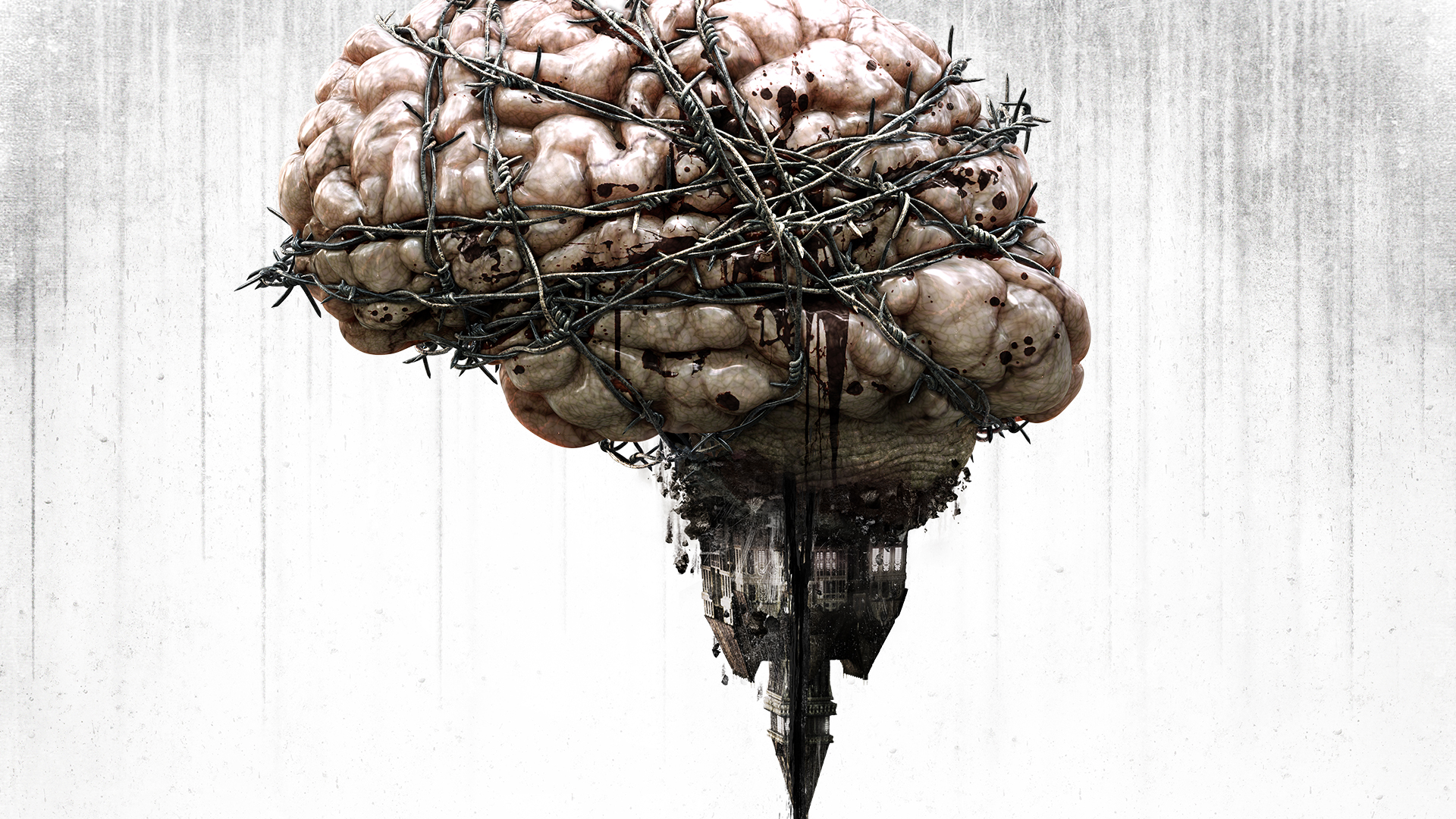
After finishing the game, there’s a much clearer symbolism to this central image to The Evil Within. In time, all will be revealed.
The Evil Within‘s characters are fine. Sebastian is the somewhat generic, gruff male protagonist who really isn’t much to make of since he’s not much for talking and is kind of a closed book. His backstory, however, reveals a nuance in the reasons why he acts the way he does and allowed me to sympathize with him on some level. Oh, he’s also a sheer treasure cove of glorious dialogue. After all of the events he goes through in the game that would drive a normal person mad, he casually remarks, “Something is wrong with this place,” and asks, “Tell me, lady. Am I going crazy?” He has this air of being inconvenienced and only slightly disturbed by his circumstances, and this unique brand of obliviousness just makes him an entertaining character in his own way. None of the other characters are that interesting, like the impassive, bland Joseph Oda and Juli Kidmann. I didn’t necessarily care for them, but Ruvik is a great antagonist: a classic sociopath with a dark past and motivations you won’t see coming. So, I’d hardly judgeThe Evil Within as having stellar character development, but in truth, they’re more of a means to an end to move the intriguing plot along, and while they aren’t original or that memorable, they “get the job done,” so to speak. All in all, the narrative is exactly what it sets itself up to be: perplexing with a purpose to the very end. Here, that type of delivery works well to the story’s advantage.
Visuals
I had the misfortune of renting the PS3 version of The Evil Within before buying it, and let me tell you it looked awful with its blurry textures. Rest assured, the PS4 version is pretty slick. Immediately I could tell the difference between the two, since the textures were much sharper, character models were more detailed, minor effects involving reflection and lighting were respectively added in and more advanced, etc. I’ve heard that – like with Resident Evil: Revelations 2 – that the graphics are not impressive, but I thought they were more than fine. Obviously, the motion capture and lack of even greater detail and lighting leave more to be desired compared to other more graphically impressive titles, but it certainly doesn’t bring the game’s presentation down, especially with some of the gorgeous backdrops and sexy physics with the characters’ hair…
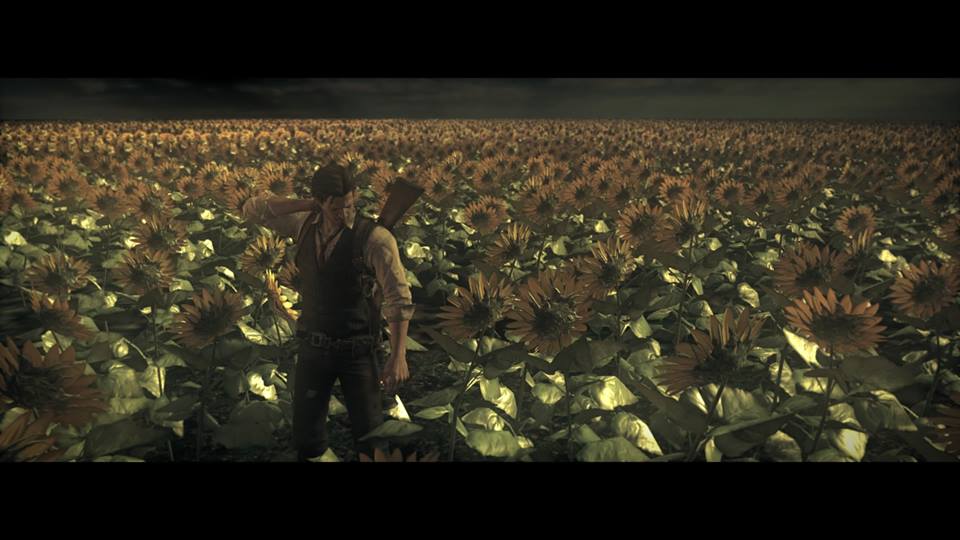
“Though I walk through the valley of the shadow of death, I will fear no evil…”
Ha, okay. In all seriousness though, the letterbox presentation and 30 frames per second are a different story. Coincidentally, I just commented on these things in my review for The Order: 1886, and The Evil Within has these constraints for the same reason: cinematic flair. There’s even a grain filter effect, but this along with the other two things do more harm than good to the graphics. You could argue it enhances the “dirtiness” of The Evil Within‘s artistic style, but I personally liked the grain filter off, and the 30 frames per second was usually fine during gameplay and cutscenes, but I noticed choppiness here and there that interrupted the otherwise consistent frame rate. The letterbox, on the other hand, is…complex. At first, I hated it to death since I was actually leaning forward in my seat to feel closer to the TV; the screen looked more distant and “squished” to me from where I usually sit. However, over time I came to accept it and thought it actually (perhaps intentionally) threw something in the difficulty with stealth sections since, when you crouch down, it’s hard to see over low walls and in the distance with that black bar in your way. Anyway, I think you get used to it, but hey, I just found out that they made full screen an option on all consoles, so that’s one thing you can play around with yourself to see if you want to experience the game in the way the developer intended or with what many players have requested since launch.One cannot simply discuss the visuals without mentioning this game’s artistic direction, and man, is it great! Due to the story,The Evil Within has a whole bunch of different, changing environments, ranging from ancient towns and mansions to a desolated, modern city and sewers. No matter where you go, every place you visit is in a downhill state. Destruction, death, and decay define this world as you look around at crumbled structures and pathways strewn with viscera and detritus of all kinds. The environments are usually oppressively dark and even claustrophobic, and when they’re not, you still get uneasy vibes no matter where you go, which really is a testament to how well The Evil Within portrays its broken reality. Everything’s unstable, and youfeel unsure and uncomfortable of your surroundings because of that, but that’s not to say that this disarray isn’t a sore sight to look at. It’s beautifully orchestrated disarray, and that extends to how I feel about the devilishly evil enemy designs, too. It’s almost like the game is a conglomeration of classic survival-horror environments and visual tropes we’ve seen over the years, but it retains a sadistic, filthy, moody, and confident artistic style I associate only with it. I love it.
Audio
The Evil Within sounds disgusting, and that’s a good thing. Enemies sound terrifying as they hiss and stumble toward you, and flesh being ripped apart by gunfire or blunt objects is appropriately gross to hear. The weapons sound all right, and besides the footsteps of Sebastian not making a sound with every step for some reason, there isn’t much to find fault with in regard to all the sound effects. However, one thing I have to specifically applaud is the ambience. Survival-horror games are particularly great at focusing on this category of audio like the first Dead Space, and while The Evil Within doesn’t overcome what it accomplished, it comes somewhat close. Sounds eerily echo across corridors, inconsequential objects in environments make noise if enemies or you interact with them (like wheelchairs and glass bottles), which help put you on edge as you listen for everything.
This beauty screams at you as she scuttles across the ground, clawing at you with her scary, long fingers. Lord, have mercy.
But what ties together with the ambience so well is the music, which, again, is something Dead Space did near perfectly by making its tracks sound like a part of the environments and action. The Evil Withinfollows suit in a less memorable way in comparison. Dead Space was extremely jarring and in your facewith its music, but this game’s soundtrack blends into the background more and is less distinct. It’s not bad, but this stripped-back music, with its dissonant strings, echo-y noises, and percussion simply isn’t memorable in itself. And lastly, the voice acting isn’t too shabby. While some of the characters sound bored (Judi and Joseph), others (Ruvik, Jimenez, and – to a degree – Sebastian) have a bit more life and personality to them. All in all, the ambience is what sells with the audio, while everything else meets standards.
Replay Value
You’ve got a campaign that’s about 17-20 hours in length on the Survival difficulty. Reminds me of the satisfying length Resident Evil 4 had of being not too short yet not too long, and that’s what this game feels like. If I had the time, I’d love to play this game a second time on the Nightmare difficulty with some of the special items you unlock after completing the game the first time around. But honestly, if you wouldn’t want to do that, going back and getting recordings, collecting these special tiles that make a map of Crimson City in the save room (I don’t know what this unlocks), and whatnot aren’t worth the time. Otherwise, one playthrough is definitely enough to justify its launch retail price, so I don’t need to tell you that for $20-30, you’re obligated to play it if you’re a survival-horror fan. In addition, there are three pieces of DLC with two minor campaigns featuring Juli Kidman and a challenge mode of sorts where you play as the Keeper. How are they? I have yet to gather my thoughts on this content. However, I plan to review them, so stay tuned to see if they are worth your time as well.
Conclusion
The thing about survival-horror is while it may be one of my favorite genres of video games, I don’t judge it by how much it “scares” me because that rarely happens…I’m talking about jumping, short yelps, and genuine fear with adrenaline. The only time I’ve experienced that is with P.T. (of all things), so I usually judge how “scary” a survival-horror game is by how stressful, tense, and immersed it makes me feel, and it succeeds on that front. I like to look at it as a meaningful love letter to pure survival-horror with gameplay that demands you to take your time and conserve your resources against aggressive foes in devilish settings. While a small portion of the design and features are rough, the majority of this game is a rock solid title sure of itself with a beautifully desolate world to explore and an insane story that’s a fun albeit slow ride to watch unfold. So, get ready. Brace the evil within The Evil Within, because there’s a peculiar brilliance to the madness of it that might just click with you as it did with me.
8.75/10

